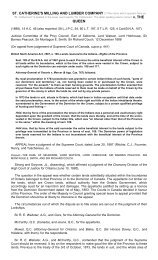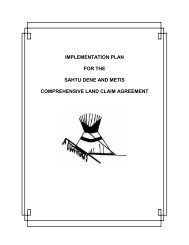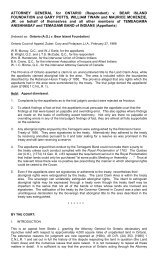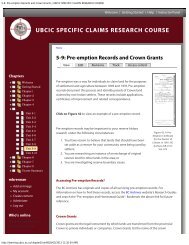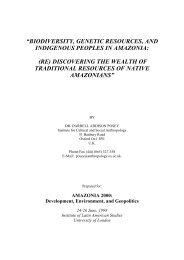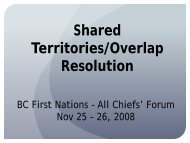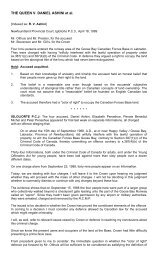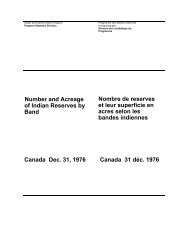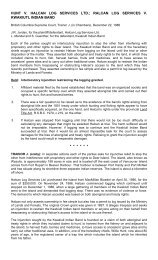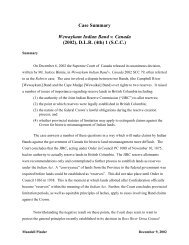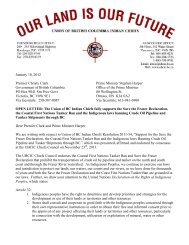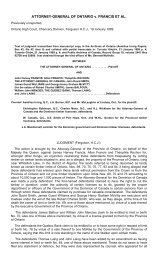Constitutional âPropertyâ and Reserve Creation: Seybold Revisited
Constitutional âPropertyâ and Reserve Creation: Seybold Revisited
Constitutional âPropertyâ and Reserve Creation: Seybold Revisited
Create successful ePaper yourself
Turn your PDF publications into a flip-book with our unique Google optimized e-Paper software.
24 MANITOBA LAW JOURNAL VOL 32 NO 1it to do this will be litigated. When this happens the issues left unresolved in <strong>Seybold</strong><strong>and</strong> related bilateral agreements will have to be examined.Lastly, if there is no convincing the reader that this approach is viable withouta substantial change to accepted political <strong>and</strong> legal norms of reserve creationthere is always resort to an argument for change. A province would no doubt arguethat to allow the federal government to reserve public l<strong>and</strong>s for Indianswithout asking permission from a province would upset the balance of federalism.In Reference Re Secession of Quebec the Supreme Court of Canada noted thatfederalism was an underlying Canadian constitutional principle:[T]here can be little doubt that the principle of federalism remains a central organizationaltheme of our Constitution. Less obviously, perhaps, but certainly of equal importance,federalism is a political <strong>and</strong> legal response to underlying social <strong>and</strong> political realities.79It must not be forgotten that the protection of minorities was also one of the“underlying” constitutional principles pronounced by the Supreme Court in thatreference, with specific reference to s. 35 of the Constitution Act, 1982 <strong>and</strong> aboriginalpeoples. While the idea that s. 91(24) was a right to manage very limitedaboriginal interests may have been in the minds of the fathers of Confederationin 1867, or indeed, in those of the Privy Council in the 1880s <strong>and</strong> 90s, it doesnot mean that it must have that connotation today. In Reference Re Same Sex Marriagethe court for the umpteenth time reaffirmed the “living tree” doctrine:A large <strong>and</strong> liberal, or progressive, interpretation ensures the continued relevance <strong>and</strong>,indeed, legitimacy of Canada's constituting document. By way of progressive interpretationour Constitution succeeds in its ambitious enterprise, that of structuring the exerciseof power by the organs of the state in times vastly different from those in which itwas crafted. 80The vain refrain that s. 91 does not confer property on the federal governmentfrom <strong>Seybold</strong>, is not the dominant tide in Canadian constitutional law. It st<strong>and</strong>sagainst the driving force of overlapping pith <strong>and</strong> substance oriented jurisdiction<strong>and</strong> the established doctrine of Crown indivisibility. It renders s. 91(1A) utterlyrepugnant. It attempts a base classification of types of sections in the ConstitutionAct, 1867 without giving a large <strong>and</strong> liberal interpretation to them.Most importantly however, it is wrong in light of s. 35(1) of the ConstitutionAct, 1982 to construe s. 109 so expansively that it ties the h<strong>and</strong>s of the federalgovernment in engaging in relationship building <strong>and</strong> reconciliation. In Delgamuukwv. British Columbia, 81 Lamer C.J. held that “[a]boriginal rights are a necessarypart of the reconciliation of aboriginal societies with the broader political798081Reference re Secession of Quebec, [1998] 2 S.C.R. 217 at para. 57.[2004] 3 S.C.R. 698, 2004 SCC 79 at para. 23.[1997] 3 S.C.R. 1010, [1997] S.C.J. No. 108 at para. 161.



